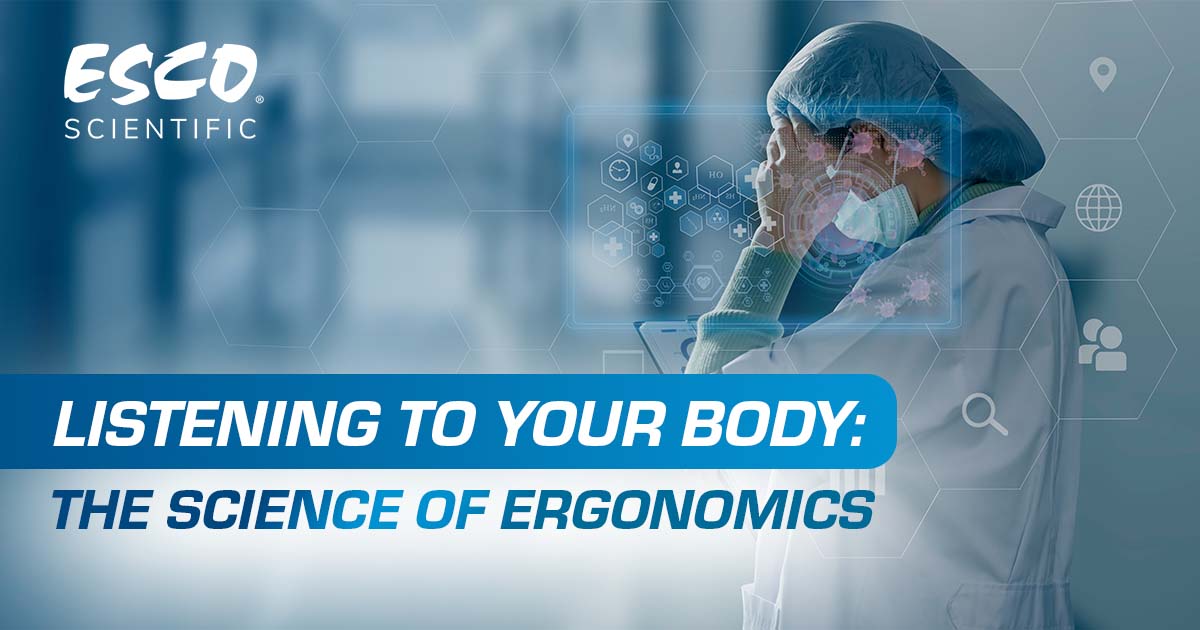Listening to Your Body: The Science of Ergonomics

A day’s work in the laboratory requires dedication and focus from every lab professional to warrant reliable results. Routinary activities in the laboratory may cause physical stress and strains that can lead to significant injuries. Hence, every lab staff needs to be reminded of the most important tool they are working with—their body.
Work-related musculoskeletal disorders
Ergonomics is all about "fitting the job to the worker." The term originates from the Greek words nomos which means "rule" and ergon which means "labor." It is the practice of modifying the work environment, such as equipment, furnishings, work pace, and so on, to meet employees' physical needs and limitations.
The five components of ergonomics are safety, comfort, ease of use, productivity/performance, and aesthetics, and all-important in preventing occupational injury, no matter what work you have. According to the National Institute for Occupational Safety and Health (NIOSH), the main purpose of ergonomics is to avoid injury or illness such as musculoskeletal disorders (MSDs). MSDs are triggered by continuous exposure to repetitive movements, vibrations, and awkward posture. Some examples of MSDs include low back pain, DeQuervain’s disease, tendinitis, rotator cuff injuries (affects the shoulder), epicondylitis (affects the elbow), trigger finger, muscle strains, and carpal tunnel syndrome.
Musculoskeletal disorders caused by workplace or working conditions are known as work-related musculoskeletal disorders.
Work-related Musculoskeletal Disorders (WMSDs) can cause the following symptoms:

Lab personnel spends remarkable periods working in a constrained sitting or standing position. Some routine work also demands a constant repetitive arm and wrist movement or prolonged fixed postures that may lead to hand injuries. This may result in decreased productivity, time off work, and temporary or permanent injuries. However, it can be avoided by using ergonomic solutions for a healthier work setting.
Integration of ergonomics in engineering controls
Since laboratory professionals are at such a high risk for WMSDs, it is vital to take precautions. That is why Esco Lifesciences Encourages Safe and Comfortable Operation in the laboratory. We design equipment with the safety and comfort of our customers in mind. Apart from being validated under international standards, our products are also ergonomically constructed to fit the working conditions of the laboratory workers.





The integration of ergonomic features to our laboratory equipment aims to promote good musculoskeletal health among lab professionals. We at Esco, care.
Read more here: Esco Lifesciences Products (A-Z), Esco Resources, The Lab Cycle: Esco Scientific Quarterly Newsletter - Issue 7, Oct - Dec 2021
References:
[1] AlNekhilan, A. F., AlTamimi, A. M., AlAqeel, B. Y., AlHawery, A. A., AlFadhel, S. F., & Masuadi, E. M. (2020, January 23). Work-related musculoskeletal disorders among clinical laboratory workers. PubMed Central (PMC). https://www.ncbi.nlm.nih.gov/pmc/articles/PMC7014994/
[2] Ergonomics and Musculoskeletal Disorders | NIOSH | CDC. (n.d.). Centers for Disease Control and Prevention. Retrieved October 27, 2021, from https://www.cdc.gov/niosh/topics/ergonomics/
[3] Laboratory Ergonomics. (n.d.). University of North Carolina at Chapel Hill. https://ehs.unc.edu/workplace-safety/ergonomics/lab/
[4] Laboratory Safety Ergonomics for the Prevention of Musculoskeletal Disorders. (n.d.). Occupational Safety and Health Administration. Retrieved October 27, 2021, from https://www.osha.gov/sites/default/files/publications/OSHAfactsheet-laboratory-safety-ergonomics.pdf
[5] Roth, C. (2011, February 1). The Importance of Ergonomics for the Safety Professional. EHS Today. https://www.ehstoday.com/archive/article/21912602/ the-importance-of-ergonomics-for-the-safety-professional
[6] The Advantages of Ergonomics. (n.d.). Oregon Occupational Safety and Health (Oregon OSHA). https://osha.oregon.gov/OSHAPubs/ergo/ergoadvantages.pdf